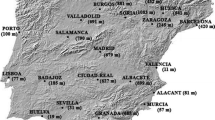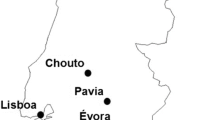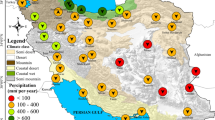Abstract
The common versions (referred to as self-calibrated here) of the Standardized Precipitation Index (SPI) and the Palmer Drought Severity Index (PDSI) are calibrated and then applied to the same weather series. Therefore, the distribution of the index values is about the same for any weather series. We introduce here the relative SPI and PDSI, abbreviated as rSPI and rPDSI. These are calibrated using a reference weather series as a first step, which is then applied to the tested series. The reference series may result from either a different station to allow for the inter-station comparison or from a different period to allow for climate-change impact assessments. The PDSI and 1–24 month aggregations of the SPI are used here. In the first part, the relationships between the self-calibrated and relative indices are studied. The relative drought indices are then used to assess drought conditions for 45 Czech stations under present (1961–2000) and future (2060–2099) climates. In the present climate experiment, the drought indices are calibrated by using the reference station weather series. Of all drought indices, the PDSI exhibits the widest spectrum of drought conditions across Czechia, in part because it depends not only on precipitation (as does the SPI) but also on temperature. In our climate-change impact experiments, the future climate is represented by modifying the observed series according to scenarios based on five Global Climate Models (GCMs). Changes in the SPI-based drought risk closely follow the modeled changes in precipitation, which is predicted to decrease in summer and increase in both winter and spring. Changes in the PDSI indicate an increased drought risk at all stations under all climate-change scenarios, which relates to temperature increases predicted by all of the GCMs throughout the whole year. As drought depends on both precipitation and temperature, we conclude that the PDSI is more appropriate (when compared to the SPI) for use in assessing the potential impact of climate change on future droughts.












Similar content being viewed by others
References
Alley WM (1984) The Palmer Drought Severity Index: limitations and assumptions. J Clim Appl Meteor 23:1100–1109
Bonaccorso B, Bordi I, Cancelliere A, Rossi G, Sutera A (2003) Spatial Variability of drought: an analysis of the SPI in Sicily. Water Resour Man 17:273–296
Bordi I, Sutera A (2001) Fifty years of precipitation: some spatially remote teleconnections. Water Resour Man 15:247–280
Brunetti M, Brunetti M, Maugeri M, Nanni T, Navarra A, Maugeri M, Nanni T, Navarra A (2002) Droughts and extreme events in regional daily Italian precipitation series. Int J Climatol 22:509–621
Byun H-R, Wilhite DA (1999) Objective quantification of drought severity and duration. J Clim 12:2747–2756
Dai A, Trenberth KE, Qian T (2004) A global dataset of Palmer Drought Severity Index for 1870–2002: relationship with soil moisture and effects of surface warming. J Hydrometeor 5:1117–1130
Dubrovsky M, Nemesova I, Kalvova J (2005) Uncertainties in climate change scenarios for the Czech Republic. Clim Res 29:139–156
Guttman NB (1994) On the sensitivity of sample L moments to sample size. J Clim 7:1026–1029
Guttman NB (1999) Accepting the Standardized Precipitation Index: a calculation algorithm. J Am Water Res Assoc 35:311–322
Hayes MJ, Svoboda MD, Wilhite DA, Vanyarkho OV (1999) Monitoring the 1996 drought using the Standardized Precipitation Index. Bull Am Meteor Soc 80:429–438
Heim RR (2002) A review of twentieth-century drought indices used in the United States. Bull Am Meteor Soc 83:1149–1165
Hisdal H, Stahl K, Tallaksen LM, Demuth S (2001) Have streamflow droughts in Europe become more severe or frequent? Int J Climatol 21:317–333
Houghton JT, Ding Y, Griggs DJ, Noguer M, van der Linden PJ, Xiaosu D (eds) (2001) Climate change 2001: the scientific basis. Contribution of Working Group I to the Third Assessment Report of the Intergovernmental Panel on Climate Change (IPCC). Cambridge University Press, Cambridge, p 944
Huth R, Kysely J, Dubrovsky M (2001) Time structure of observed, GCM-simulated, downscaled, and stochastically generated daily temperature series. J Clim 14:4047–4061
Jones PD, Hulme M, Briffa KR, Jones CG (1996) Summer moisture availability over Europe in the Hadley centre general circulation model based on the Palmer drought severity index. Int J Climatol 16:155–172
Karl TR, Knight RW (1985) Atlas of monthly Palmer hydrological drought indices (1931–1983) for the contiguous United States. Historical climatology Series 3–7. National Climatic Data Center, Asheville, NC
Keyantash J, Dracup JA (2002) The quantification of drought: an evaluation of the drought indices. Bull Am Meteor Soc 83:1167–1180
Lana X, Serra C, Burgueno A (2001) Patterns of monthly rainfall shortage and excess in terms of the standardized precipitation index for Catalonia (NE Spain). Int J Climatol 21:1669–1691
Lloyd-Hughes B, Saunders MA (2002) A drought climatology for Europe. Int J Climatol 22:1571–1592
Martin-Vide J, Gomez L (1999) Regionalization of Peninsular Spain based on the length of dry spells. Int J Climatol 19:537–555
McCarthy JJ, Canziani OF, Leary NA, Dokken DJ, White KS (eds) (2001) Climate change 2001: impacts, adaptation & vulnerability. Contribution of Working Group II to the Third Assessment Report of the Intergovernmental Panel on Climate Change (IPCC). Cambridge University Press, Cambridge, p. 1000
McKee TB, Doesken NJ, Kleist J (1993) Drought monitoring with multiple timescales. Preprints, Eighth Conf. on Applied Climatology, Anaheim, CA, Am Meteor. Soc., pp. 179–184
Mitchell TD, Jones PD (2005) An improved method of constructing a database of monthly climate observations and associated high-resolution grids. Int J Climatol 25:693–712
Oliver JE (ed) (2005) Encyclopedia of world climatology. Encyclopedia of Earth Sciences Series, Springer, Berlin Heidelberg New York, p 855
Palmer WC (1965) Meteorological drought. Weather Bureau, Research Paper No. 45, U.S. Dept. of Commerce, Washington, DC, p 58
Piccarreta M, Capolongo D, Boenzi F (2004) Trend analysis of precipitation and drought in Basilicata from 1923 to 2000 within a Southern Italy context. Int J Climatol 24:907–922
Redmond KT (2002) The depiction of drought. Bull Am Meteor Soc 83:1145–1147
Rouault M, Richard Y (2003) Intensity and spatial extension of drought in South Africa at different time scales. Water SA, vol 29, 489–500 [available free from http://www.wrc.org.za]
Seiler RA, Hayes M, Bressan L (2002) Using the standardized precipitation index for flood risk monitoring. Int J Climatol 22:1365–1376
Smith JB, Huq S, Lenhart S, Mata LJ, Nemesova I, Toure S (1996) Vulnerability and adaptation to climate change: interim results from the U.S. country studies program. Kluwer, Dordrecht, p 366
Svoboda MD, LeComte D, Hayes MJ, Heim R, Gleason K, Angel J, Rippey B, Tinker R, Palecki M, Stooksbury D, Miskus D, Stevens D (2002) The drought monitor. Bull Am Meteor Soc 83:1181–1190
Szalai S, Szinell C (2000) Statistical tests for drought tendency investigations and their sensitivity. In: Proc. 12th Conference on Applied Climatology, AMS, Boston, MA, pp 243–246
Szinell CS, Bussay A, Szentimrey T (1998) Drought tendencies in Hungary. Int J Climatol 18:1479–1491
Tolasz R, Mikova T, Valerianova A (eds) (2006) Climatic Atlas of Czechia, ČHMÚ (in press)
Tomasek M (200) Pudy Ceske republiky. CGU, Praha, p 67
Touchan R, Funkhouser G, Hughes MK, Erkan N (2005) Standardized Precipitation Index Reconstructed from Turkish Tree-ring Widths. Clim Change 72:339–353
Trnka M, Dubrovsky M, Svoboda MD, Semeradova D, Hayes MJ, Zalud Z, Wilhite DA (2008) Developing a regional drought climatology for the Czech Republic for 1961–2000. submitted to Int J Climatol (August 06)
van der Schrier G, Briffa KR, Jones PD, Osborn TJ (2006) Summer moisture variability across Europe. J. Climate 19:2818–2834
Vicente-Serrano SM, Beguería S (2003) Estimating extreme dry-spell risk in the middle Ebro valley (Northeastern Spain): a comparative analysis of partial duration series with a General Pareto distribution and annual maxima series with a Gumbel distribution. Int J Climatol 23:1103–1118
Vicente-Serrano SM, González-Hidalgo JC, de Luis M, Raventós J (2004) Drought patterns in the Mediterranean area: the Valencia region (eastern Spain). Clim Res 26:5–15
Watson RT, Zinyowera MC, Moss RH (eds) (1997) The regional impacts of climate change: an assessment of vulnerability. Cambridge University Press, Cambridge, p 517
Wells N, Goddard S, Hayes MJ (2004) A self-calibrating Palmer Drought Severity Index. J Clim 17:2335–2351
Wilhite DA (2000) Drought as a natural hazard: concepts and definitions. In: Wilhite DA (ed) Drought: a global assessment, Routledge, pp 3–18
Woodhouse CA, Brown PM (2001) Tree-ring evidence for Great Plains drought. Tree-Ring Res 59:89–103
Woodhouse CA, Lukas JJ, Brown PM (2002) Drought in the Western Great Plains, 1845–56. Bull Am Meteor Soc 83:1485–1493
Wu H, Hayes MJ, Wilhite DA, Svoboda MD (2005) The effect of the length of record on the standardized precipitation index calculation. Int J Climatol 25:505–520
Zou X, Zhai P, Zhang Q (2005) Variations in droughts over China: 1951–2003. Geoph Res Lett 32:L04707
Acknowledgements
The present study was sponsored by the Grant Agency of the Czech Republic (Project 205/05/2265 - “Calibration of Weather Generator for Sites without or with Incomplete Meteorological Observations”) and by the Ministry of Education, Youth and Sports of the Czech Republic (Research plan No. MSM6215648905 “Biological and Technological Aspects of Sustainability of Controlled Ecosystems and their Adaptability to Climate Change”). We also acknowledge support from the KONTAKT project ME 844, which has enabled intensive co-operation between the authors. We are grateful to Shifeng Zhang (Computer Science & Engineering Department, University of Nebraska, Lincoln), who made the necessary modifications to the source code of the PDSI. The Czech weather station data were provided by the Czech Hydrometeorological Institute.
Author information
Authors and Affiliations
Corresponding author
Rights and permissions
About this article
Cite this article
Dubrovsky, M., Svoboda, M.D., Trnka, M. et al. Application of relative drought indices in assessing climate-change impacts on drought conditions in Czechia. Theor Appl Climatol 96, 155–171 (2009). https://doi.org/10.1007/s00704-008-0020-x
Received:
Accepted:
Published:
Issue Date:
DOI: https://doi.org/10.1007/s00704-008-0020-x




